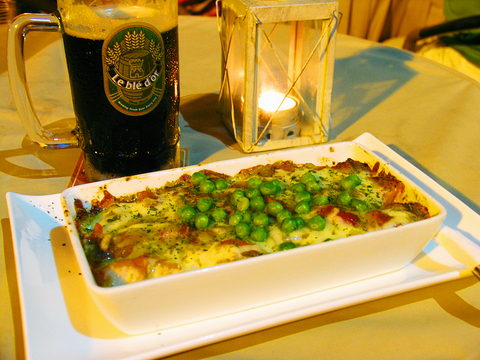Now that the government isn't the only one allowed to brew beer, there are several local startup breweries worth giving a try and others that are worth giving several tries. In the latter group is Le ble d'or, the beer garden located in the courtyard area of the Asia World shopping center.
Of course, Le ble d'or's main selling point is the three beers the company brews itself in Hshichih (
While few diners seemed interested in enjoying a meal outdoors after Le ble d'or opened last August, the place has seen a steadily increasing number of patrons willing to sample their menu of European cuisine and local favorites.

PHOTO: DAVID MOMPHARD, TAIPEI TIMES
Hungarian beef stew with rice shares the menu with a host of seafood dishes; spicy cuttlefish, seafood pizza, seafood chowder and baked mussels, to name a few. But the majority of the menu is given over to what would otherwise be considered pub grub: deep-fried chicken nuggets, nachos and the like. These are served in generous portions (and should be given the prices they carry at NT$280 for a basket of chicken nuggets or NT$250 for nachos) and help the beers go down better.
On my last visit, I had the baked Hungarian beef stew with rice. The beef was of a good quality, but there could have been more of it and the dish would have sat better atop a long-grain rice instead of the local variety. The compromise here is that the rice is prepared loose, not sticky, and soaks up more of the dish's flavor.
And if nothing on the menu tempts your taste buds, there is always the beer. Since it's prepared fresh and not pasteurized it retains more nutritional value than the regular bottled beer. Of the three varieties available, the stout is most like a meal in itself (though it's not as bitter as many European stouts). The Weissen is a personal favorite. With the sediments filtered out, it retains a cloudiness that goes quickly to your head upon drinking the 500cc-sized serving. The most popular is Le ble d'or's lager. It's the most like Taiwan Beer, but a refreshing change from the nation's flagship brew.

Most heroes are remembered for the battles they fought. Taiwan’s Black Bat Squadron is remembered for flying into Chinese airspace 838 times between 1953 and 1967, and for the 148 men whose sacrifice bought the intelligence that kept Taiwan secure. Two-thirds of the squadron died carrying out missions most people wouldn’t learn about for another 40 years. The squadron lost 15 aircraft and 148 crew members over those 14 years, making it the deadliest unit in Taiwan’s military history by casualty rate. They flew at night, often at low altitudes, straight into some of the most heavily defended airspace in Asia.

Taiwan’s democracy is at risk. Be very alarmed. This is not a drill. The current constitutional crisis progressed slowly, then suddenly. Political tensions, partisan hostility and emotions are all running high right when cool heads and calm negotiation are most needed. Oxford defines brinkmanship as: “The art or practice of pursuing a dangerous policy to the limits of safety before stopping, especially in politics.” It says the term comes from a quote from a 1956 Cold War interview with then-American Secretary of State John Foster Dulles, when he said: ‘The ability to get to the verge without getting into the war is

Beijing’s ironic, abusive tantrums aimed at Japan since Japanese Prime Minister Sanae Takaichi publicly stated that a Taiwan contingency would be an existential crisis for Japan, have revealed for all the world to see that the People’s Republic of China (PRC) lusts after Okinawa. We all owe Takaichi a debt of thanks for getting the PRC to make that public. The PRC and its netizens, taking their cue from the Chinese Communist Party (CCP), are presenting Okinawa by mirroring the claims about Taiwan. Official PRC propaganda organs began to wax lyrical about Okinawa’s “unsettled status” beginning last month. A Global

Like much in the world today, theater has experienced major disruptions over the six years since COVID-19. The pandemic, the war in Ukraine and social media have created a new normal of geopolitical and information uncertainty, and the performing arts are not immune to these effects. “Ten years ago people wanted to come to the theater to engage with important issues, but now the Internet allows them to engage with those issues powerfully and immediately,” said Faith Tan, programming director of the Esplanade in Singapore, speaking last week in Japan. “One reaction to unpredictability has been a renewed emphasis on